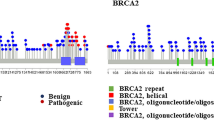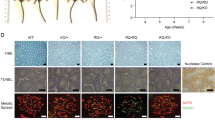Abstract
A number of germ-line mutations in the BRCA1 gene confer susceptibility to breast and ovarian cancer. However, it remains difficult to determine whether many single amino-acid (missense) changes in the BRCA1 protein that are frequently detected in the clinical setting are pathologic or not. Here, we used a combination of functional, crystallographic, biophysical, molecular and evolutionary techniques, and classical genetic segregation analysis to demonstrate that the BRCA1 missense variant M1775K is pathogenic. Functional assays in yeast and mammalian cells showed that the BRCA1 BRCT domains carrying the amino-acid change M1775K displayed markedly reduced transcriptional activity, indicating that this variant represents a deleterious mutation. Importantly, the M1775K mutation disrupted the phosphopeptide-binding pocket of the BRCA1 BRCT domains, thereby inhibiting the BRCA1 interaction with the proteins BRIP1 and CtIP, which are involved in DNA damage-induced checkpoint control. These results indicate that the integrity of the BRCT phosphopeptide-binding pocket is critical for the tumor suppression function of BRCA1. Moreover, this study demonstrates that multiple lines of evidence obtained from a combination of functional, structural, molecular and evolutionary techniques, and classical genetic segregation analysis are required to confirm the pathogenicity of rare variants of disease-susceptibility genes and obtain important insights into the underlying pathogenetic mechanisms.
Similar content being viewed by others
Log in or create a free account to read this content
Gain free access to this article, as well as selected content from this journal and more on nature.com
or
Accession codes
References
Goldgar DE, Easton DF, Deffenbaugh AM, Monteiro AN, Tavtigian SV, Couch FJ : Integrated evaluation of DNA sequence variants of unknown clinical significance: application to BRCA1 and BRCA2. Am J Hum Genet 2004; 75: 535–544.
Chenevix-Trench G, Healey S, Lakhani S et al: Genetic and histopathologic evaluation of BRCA1 and BRCA2 DNA sequence variants of unknown clinical significance. Cancer Res 2006; 66: 2019–2027.
Hayes F, Cayanan C, Barilla D, Monteiro AN : Functional assay for BRCA1: mutagenesis of the COOH-terminal region reveals critical residues for transcription activation. Cancer Res 2000; 60: 2411–2418.
Cantor SB, Bell DW, Ganesan S et al: BACH1, a novel helicase-like protein, interacts directly with BRCA1 and contributes to its DNA repair function. Cell 2001; 105: 149–160.
Seal S, Thompson D, Renwick A et al: Truncating mutations in the Fanconi anemia J gene BRIP1 are low-penetrance breast cancer susceptibility alleles. Nat Genet 2006; 38: 1239–1241.
Yu X, Chen J : DNA damage-induced cell cycle checkpoint control requires CtIP, a phosphorylation-dependent binding partner of BRCA1 C-terminal domains. Mol Cell Biol 2004; 24: 9478–9486.
Ng PC, Henikoff S : SIFT: predicting amino acid changes that affect protein function. Nucleic Acids Res 2003; 31: 3812–3814.
Tavtigian SV, Deffenbaugh AM, Yin L et al: Comprehensive statistical study of 452 BRCA1 missense substitutions with classification of eight recurrent substitutions as neutral. J Med Genet 2006; 43: 295–305.
Easton DF, Deffenbaugh AM, Pruss D et al: A systematic genetic assessment of 1433 sequence variants of unknown clinical significance in the BRCA1 and BRCA2 breast cancer-predisposition genes. Am J Hum Genet 2007; 81: 873–883.
Lakhani SR, Van De Vijver MJ, Jacquemier J . et al: The pathology of familial breast cancer: predictive value of immunohistochemical markers estrogen receptor, progesterone receptor, HER-2, and p53 in patients with mutations in BRCA1 and BRCA2. J Clin Oncol 2002; 20: 2310–2318.
van Beers EH, Joosse SA, Ligtenberg MJ et al: A multiplex PCR predictor for aCGH success of FFPE samples. Br J Cancer 2006; 94: 333–337.
Joosse SA, van Beers EH, Nederlof PM : Automated array-CGH optimized for archival formalin-fixed, paraffin-embedded tumor material. BMC Cancer 2007; 7: 43.
Picard F, Robin S, Lavielle M, Vaisse C, Daudin JJ : A statistical approach for array CGH data analysis. BMC Bioinformatics 2005; 6: 27.
Tibshirani R, Hastie T, Narasimhan B, Chu G : Diagnosis of multiple cancer types by shrunken centroids of gene expression. Proc Natl Acad Sci USA 2002; 99: 6567–6572.
Joosse SA, Van Beers EH, Tielen IHG et al: Submitted.
Carvalho MA, Marsillac SM, Karchin R et al: Determination of cancer risk associated with germ line BRCA1 missense variants by functional analysis. Cancer Res 2007; 67: 1494–1501.
Higuchi R : Recombinant PCR; in Innis MA, Gelfand DH, Sninsky JJ, White TJ (eds): PCR Protocols: a Guide to Methods and Applications. San Diego, CA: Academic Press Inc., 1989, pp 177–183.
Phelan CM, Dapic V, Tice B et al: Classification of BRCA1 missense variants of unknown clinical significance. J Med Genet 2005; 42: 138–146.
Carvalho MA, Couch FJ, Monteiro AN : Functional assays for BRCA1 and BRCA2. Int J Biochem Cell Biol 2007; 39: 298–310.
Estojak J, Brent R, Golemis EA : Correlation of two-hybrid affinity data with in vitro measurements. Mol Cell Biol 1995; 15: 5820–5829.
Golemis EA, Gyuris J, Brent R : Two-hybrid system/interaction traps; in Ausubel FM, Brent R, Kingston R et al (eds): Current Protocols in Molecular Biology. New York: John Wiley and Sons, 1994, pp 13.14.11–13.14.17.
Brent R, Ptashne M : A eukaryotic transcriptional activator bearing the DNA specificity of a prokaryotic repressor. Cell 1985; 43: 729–736.
Otwinowski Z, Minor W : Processing of X-ray diffraction data collected in oscillation mode. Methods Enzymol 1997; 276: 307–326.
Vagin A, Teplyakov A : MOLREP: an automated program for molecular replacement. J Appl Crystallogr 1997; 30: 1022–1025.
Emsley P, Cowtan K : Coot: model-building tools for molecular graphics. Acta Crystallogr D Biol Crystallogr 2004; 60: 2126–2132.
Murshudov GN, Vagin AA, Dodson EJ : Refinement of macromolecular structures by the maximum-likelihood method. Acta Crystallogr D Biol Crystallogr 1997; 53: 240–255.
Thompson D, Easton DF, Goldgar DE : A full-likelihood method for the evaluation of causality of sequence variants from family data. Am J Hum Genet 2003; 73: 652–655.
Joosse SA, Van Beers EH, Tielen IHG et al: Submitted.
Wessels LF, van Welsem T, Hart AA, van't Veer LJ, Reinders MJ, Nederlof PM : Molecular classification of breast carcinomas by comparative genomic hybridization: a specific somatic genetic profile for BRCA1 tumors. Cancer Res 2002; 62: 7110–7117.
Williams RS, Glover JN : Structural consequences of a cancer-causing BRCA1-BRCT missense mutation. J Biol Chem 2003; 278: 2630–2635.
Varma AK, Brown RS, Birrane G, Ladias JA : Structural basis for cell cycle checkpoint control by the BRCA1-CtIP complex. Biochemistry 2005; 44: 10941–10946.
Fenn TD, Ringe D, Petsko GA : POVScript+: a program for model and data visualization using persistence of vision ray-tracing. J Appl Crystallogr 2003; 36: 944–947.
Nicholls A, Sharp KA, Honig B : Protein folding and association: insights from the interfacial and thermodynamic properties of hydrocarbons. Proteins 1991; 11: 281–296.
Clapperton JA, Manke IA, Lowery DM et al: Structure and mechanism of BRCA1 BRCT domain recognition of phosphorylated BACH1 with implications for cancer. Nat Struct Mol Biol 2004; 11: 512–518.
Shiozaki EN, Gu L, Yan N, Shi Y : Structure of the BRCT repeats of BRCA1 bound to a BACH1 phosphopeptide: implications for signaling. Mol Cell 2004; 14: 405–412.
Cornelis RS, Neuhausen SL, Johansson O et al: High allele loss rates at 17q12–q21 in breast and ovarian tumors from BRCAl-linked families. The Breast Cancer Linkage Consortium. Genes Chromosomes Cancer 1995; 13: 203–210.
Osorio A, de la Hoya M, Rodriguez-Lopez R et al: Loss of heterozygosity analysis at the BRCA loci in tumor samples from patients with familial breast cancer. Int J Cancer 2002; 99: 305–309.
Smith SA, Easton DF, Evans DG, Ponder BA : Allele losses in the region 17q12–21 in familial breast and ovarian cancer involve the wild-type chromosome. Nat Genet 1992; 2: 128–131.
Vallon-Christersson J, Cayanan C, Haraldsson K et al: Functional analysis of BRCA1 C-terminal missense mutations identified in breast and ovarian cancer families. Hum Mol Genet 2001; 10: 353–360.
Karchin R, Monteiro AN, Tavtigian SV, Carvalho MA, Sali A : Functional impact of missense variants in BRCA1 predicted by supervised learning. PLoS Comput Biol 2007; 3: e26.
Mirkovic N, Marti-Renom MA, Weber BL, Sali A, Monteiro AN : Structure-based assessment of missense mutations in human BRCA1: implications for breast and ovarian cancer predisposition. Cancer Res 2004; 64: 3790–3797.
Monteiro AN, Couch FJ : Cancer risk assessment at the atomic level. Cancer Res 2006; 66: 1897–1899.
Morris JR, Pangon L, Boutell C, Katagiri T, Keep NH, Solomon E : Genetic analysis of BRCA1 ubiquitin ligase activity and its relationship to breast cancer susceptibility. Hum Mol Genet 2006; 15: 599–606.
Williams RS, Lee MS, Hau DD, Glover JN : Structural basis of phosphopeptide recognition by the BRCT domain of BRCA1. Nat Struct Mol Biol 2004; 11: 519–525.
Manke IA, Lowery DM, Nguyen A, Yaffe MB : BRCT repeats as phosphopeptide-binding modules involved in protein targeting. Science 2003; 302: 636–639.
Yu X, Wu LC, Bowcock AM, Aronheim A, Baer R : The C-terminal (BRCT) domains of BRCA1 interact in vivo with CtIP, a protein implicated in the CtBP pathway of transcriptional repression. J Biol Chem 1998; 273: 25388–25392.
Scully R, Ganesan S, Vlasakova K, Chen J, Socolovsky M, Livingston DM : Genetic analysis of BRCA1 function in a defined tumor cell line. Mol Cell 1999; 4: 1093–1099.
Monteiro AN, August A, Hanafusa H : Evidence for a transcriptional activation function of BRCA1 C-terminal region. Proc Natl Acad Sci USA 1996; 93: 13595–13599.
Acknowledgements
We thank the staff at the NSLS for assistance during data collection and Dr Donald Coen at Harvard Medical School for providing access to the microcalorimeter facility. This study was supported by grants DK062162 and AG021964 from the National Institutes of Health, and DAMD170210300 and DAMD170310563 from the US Department of Defense to JAAL, by the Jewish General Hospital Weekend to End Breast Cancer, Rethink Breast Cancer Canada, The Canadian Foundation for Innovation (MT), the Canadian Breast Cancer Research Alliance (WDF), Florida Breast Cancer Coalition, and National Institutes of Health CA92309 and CA116167 (ANAM) and the Dutch Cancer Society/Koningin Wilhelmina Fonds (PMN). We thank Heather Thorne, Sue Healey (QIMR), Eveline Niedermayr, all the kConFab research nurses and staff, the heads and staff of the Family Cancer Clinics, and the Clinical Follow Up Study (funded by NHMRC grants 145684 and 288704 and 454508) for their contributions to this resource, and the many families who contribute to kConFab. kConFab is supported by grants from the National Breast Cancer Foundation, the National Health and Medical Research Council (NHMRC) and by the Queensland Cancer Fund, the Cancer Councils of New South Wales, Victoria, Tasmania and South Australia, and the Cancer Foundation of Western Australia. WDF holds a Fonds de la Recherche en Santé du Québec (FRSQ) national scientist award and MT holds a FRSQ clinician-scientist award.
Author information
Authors and Affiliations
Consortia
Corresponding author
Additional information
Supplementary Information accompanies the paper on European Journal of Human Genetics website (http://www.nature.com/ejhg)
Supplementary information
Rights and permissions
About this article
Cite this article
Tischkowitz, M., Hamel, N., Carvalho, M. et al. Pathogenicity of the BRCA1 missense variant M1775K is determined by the disruption of the BRCT phosphopeptide-binding pocket: a multi-modal approach. Eur J Hum Genet 16, 820–832 (2008). https://doi.org/10.1038/ejhg.2008.13
Received:
Revised:
Accepted:
Published:
Issue date:
DOI: https://doi.org/10.1038/ejhg.2008.13
Keywords
This article is cited by
-
Novel mutations in actionable breast cancer genes by targeted sequencing in an ethnically homogenous cohort
BMC Medical Genetics (2019)
-
Trans-activation-based risk assessment of BRCA1 BRCT variants with unknown clinical significance
Human Genomics (2018)
-
A comparison of cosegregation analysis methods for the clinical setting
Familial Cancer (2018)
-
Multimodel assessment of BRCA1 mutations in Taiwanese (ethnic Chinese) women with early-onset, bilateral or familial breast cancer
Journal of Human Genetics (2012)
-
Prediction of BRCA2-association in hereditary breast carcinomas using array-CGH
Breast Cancer Research and Treatment (2012)



